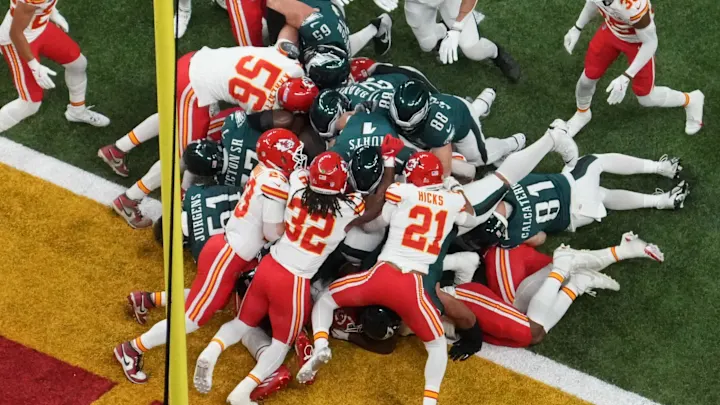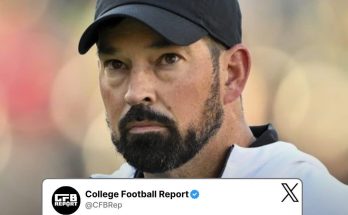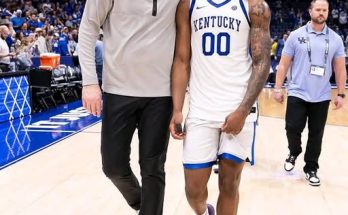The National Football League (NFL) is no stranger to controversy, but one issue brewing ahead of a key league vote on Tuesday has stirred up particular tensions between head coaches, league officials, and team executives. A contentious play—one that has divided the football world—has ignited a private dispute among some of the league’s most influential figures. As the NFL prepares for a crucial vote on the matter, it’s clear that the outcome will have significant ramifications not only for the game’s on-field product but also for the league’s future policies and reputation.
The dispute, which centers around a particular play or series of plays that have generated substantial debate, is more than just a disagreement about the rules; it speaks to deeper issues surrounding safety, fairness, and the very essence of the game. From coaches who feel the proposed changes would hinder their ability to compete to league officials who argue for the need for modernization, the division is sharp.
The Play in Question: A Controversial Rule That’s Divided the NFL
The contentious play at the heart of this dispute involves a specific aspect of the game that has become a focal point of discussion in recent seasons. While the exact nature of the play is still under wraps due to the private nature of the dispute, it’s understood to involve a key facet of the game—likely related to the evolving dynamics of offensive and defensive play, with safety concerns at the forefront.
Over the past few seasons, the NFL has introduced new rules aimed at improving player safety, especially concerning head injuries, concussions, and physical play. These changes have been met with mixed reactions. Some believe these changes are necessary to protect players and the long-term health of the league, while others argue that they fundamentally alter the game’s nature, making it less physical and more difficult to watch for fans.
The play that is currently under dispute falls somewhere within this larger context of safety concerns, player health, and the evolving dynamics of professional football. Some coaches and team officials feel that the proposed change will disproportionately benefit offenses at the expense of defensive players, thereby shifting the balance of the game in favor of the offense in a way that could make games less exciting and more predictable.
Others, however, argue that the play has a disproportionate impact on player safety, leading to unnecessary risk and possible injury. They believe that making changes to the play would address this issue head-on and create a safer environment for all players involved.
Regardless of which side of the debate one falls on, it’s clear that this play has ignited a passionate and emotional argument that has divided the league’s decision-makers.
The Private Dispute: A Tense Backroom Debate
As Tuesday’s league vote looms large, several head coaches and league officials gathered privately on Monday to hash out their differences over the play. These behind-the-scenes discussions were heated, with emotions running high as coaches—who stand to be most affected by any rule changes—voiced their concerns.
One of the main points of contention involved how the change would impact teams’ strategic approaches to the game. Coaches from both sides of the debate expressed strong views about the potential long-term effects of the proposed change. Coaches who are in favor of the new rule believe it would open up the game, making it more exciting and allowing offenses to be more dynamic. They argue that the change would create more opportunities for big plays and scoring, which would make the game more appealing to fans and television networks alike.
On the other hand, coaches opposing the change argue that it would fundamentally alter how the game is played, giving offenses an unfair advantage and rendering defensive schemes less effective. These coaches contend that football is a balanced game, and that any change that tilts the balance too far in favor of one side is ultimately harmful to the integrity of the sport. Many of these coaches have spent years building their teams around defensive strength, and they fear that changes to the rules will render their efforts in vain.
League officials, including referees and executives, were also heavily involved in the discussion, as they are the ones who will ultimately be tasked with enforcing the new rule if it is passed. These officials were divided as well, with some arguing that the change is necessary to improve player safety and reduce the likelihood of serious injuries, while others voiced concerns that it would lead to more confusion and inconsistency in officiating, potentially making the game harder to manage.
The dispute escalated when certain individuals from both sides began questioning the motives behind the rule change. Some coaches, particularly those with strong ties to defensive play, expressed concerns that the NFL’s desire to cater to fan preferences for high-scoring games was compromising the competitive balance of the sport. They argued that the league’s leadership, eager to increase viewership and revenue, was making decisions that prioritized entertainment over the preservation of football’s traditional values.
Conversely, league officials argued that the proposed changes were designed to ensure the long-term viability of the sport. They pointed to the increasing number of injuries, particularly concussions, as a key reason for the need to modernize the game. With player safety under intense scrutiny from the public and legal entities alike, officials stressed that any rule changes were made with the intent of safeguarding the health of the players, even if it meant some sacrifices in terms of traditional gameplay.
As tensions grew, a few high-profile coaches reportedly raised their voices in frustration, challenging league officials on their stance and accusing them of prioritizing safety over the integrity of the game. A few coaches even threatened to publicly oppose the rule change, stating that it would severely impact their teams and their ability to compete at the highest level.
The Vote and What’s at Stake
Tuesday’s league vote is set to be one of the most consequential in recent memory. While the exact details of the rule change remain unclear to the public, it’s clear that whatever decision is made will have a lasting impact on the way the game is played. If the rule passes, it could have widespread effects on team strategies, offensive and defensive balance, and overall player health.
The most immediate impact will likely be felt by defensive teams. A rule change that benefits the offense could make it harder for defensive players to stop high-powered attacks, potentially leading to a shift in the balance of power within the league. Teams with elite quarterbacks and playmakers, already favored by the current trends in the NFL, could stand to gain even more of an advantage. Meanwhile, teams that pride themselves on their defensive prowess could find themselves on the back foot, having to rethink their strategies and adapt to a changing game.
If the rule change passes, it could also shift the way teams approach the draft and free agency. Teams with elite defensive players might be less inclined to invest in traditional defensive stalwarts, instead opting for players who are better suited to the evolving nature of the game. Conversely, offenses may benefit from an influx of talent and resources that will be aimed at creating more high-powered and dynamic units.
The broader impact of the vote could also extend to how the league is perceived by fans. Supporters of offensive play could be thrilled by the prospect of seeing more explosive and high-scoring games, while purists and traditionalists may decry the rule change as the beginning of the end for the physical, strategic nature of football. The NFL, often viewed as a leader in sports entertainment, will be walking a fine line as it seeks to balance the interests of players, coaches, and fans while keeping player safety and the future of the game in mind.
The Road Ahead: What the Future Holds for the NFL
As the NFL votes on this contentious rule change, it’s clear that the outcome will have major ramifications for the future of the game. The league is at a crossroads, grappling with how to evolve in the face of growing concerns over player safety while preserving the integrity of the game that has made it the most popular sport in America.
While the final vote on Tuesday will ultimately determine the direction the league takes, it’s apparent that the discussions leading up to this point have been far more than just a debate over a single play. They represent a broader discussion about how the NFL must adapt to an ever-changing landscape, balancing safety concerns, entertainment values, and the competitive integrity of the sport.
Whether the rule passes or not, the league will continue to evolve, as it always has. The NFL is a league defined by its ability to adapt and grow, and while these private disputes over controversial plays may be heated, they are an essential part of shaping the future of the game. Whatever the outcome, the league will continue to work toward making football a safer, more exciting sport for players and fans alike.



